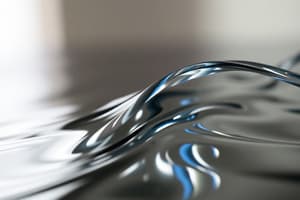Podcast
Questions and Answers
Which type of wave interaction describes a wave bending when it enters a new medium?
Which type of wave interaction describes a wave bending when it enters a new medium?
- Reflection
- Absorption
- Refraction (correct)
- Diffraction
The angle of incidence is always equal to the angle of absorption.
The angle of incidence is always equal to the angle of absorption.
False (B)
What is the outcome when waves reflect off a surface?
What is the outcome when waves reflect off a surface?
The waves bounce off the surface without being absorbed.
During ________, a wave can bend around a barrier or through an opening.
During ________, a wave can bend around a barrier or through an opening.
Match the type of wave interaction with its definition:
Match the type of wave interaction with its definition:
What happens to wave speed when moving from air to water?
What happens to wave speed when moving from air to water?
All waves travel in straight lines regardless of the medium they enter.
All waves travel in straight lines regardless of the medium they enter.
Why does a black object appear black?
Why does a black object appear black?
Destructive interference occurs when two waves combine to create a wave with a larger amplitude.
Destructive interference occurs when two waves combine to create a wave with a larger amplitude.
What occurs during absorption as a wave interacts with a material?
What occurs during absorption as a wave interacts with a material?
What are the points with zero amplitude in a standing wave called?
What are the points with zero amplitude in a standing wave called?
___ is the increase in amplitude of a vibration when external vibrations match an object's natural frequency.
___ is the increase in amplitude of a vibration when external vibrations match an object's natural frequency.
Match the following terms with their definitions:
Match the following terms with their definitions:
How is a wave created?
How is a wave created?
Standing waves can only form when two waves are moving in the same direction.
Standing waves can only form when two waves are moving in the same direction.
Give an example of a musical instrument that uses standing waves and resonance.
Give an example of a musical instrument that uses standing waves and resonance.
are there waves called Gatima
are there waves called Gatima
Flashcards
Reflection
Reflection
When a wave strikes a surface it cannot pass through, it bounces back. The wave's energy isn't absorbed or changed, but reflected away.
Refraction
Refraction
The bending of a wave as it passes from one medium to another. This happens because the wave changes speed.
Absorption
Absorption
Waves can be absorbed by certain materials. When this happens, the energy of the wave is transferred to the material.
The Law of Reflection
The Law of Reflection
Signup and view all the flashcards
Diffraction
Diffraction
Signup and view all the flashcards
Interference
Interference
Signup and view all the flashcards
Wave Speed & Medium
Wave Speed & Medium
Signup and view all the flashcards
Constructive Interference
Constructive Interference
Signup and view all the flashcards
Destructive Interference
Destructive Interference
Signup and view all the flashcards
Standing Wave
Standing Wave
Signup and view all the flashcards
Nodes
Nodes
Signup and view all the flashcards
Antinodes
Antinodes
Signup and view all the flashcards
Resonance
Resonance
Signup and view all the flashcards
Resonance
Resonance
Signup and view all the flashcards
Wave Creation
Wave Creation
Signup and view all the flashcards
Study Notes
Turn and Talk: Notice and Wonder
- Students should look at an image and write down 2-3 things they notice (key details, main ideas, themes)
- Students should then write down 2-3 things they wonder (questions, curiosities)
- Students discuss with a partner then share with the class
Wave Interactions
- Waves can be reflected, absorbed, or transmitted through various materials
- Reflection: A wave bounces off a medium
- Refraction: Bending of a wave as it enters a new medium
- Absorption: Energy of a wave is transferred to the material it hits (e.g. waves on the shore)
- Diffraction: Bending of a wave around a barrier or through an opening
- Interference: When two or more waves overlap
- Constructive Interference: Waves combine to create a wave with a larger amplitude
- Destructive Interference: Waves combine to create a smaller amplitude wave
Standing Waves
- A wave that appears to stand in one place
- Occurs when two waves interfere with each other in opposite directions
- Standing waves have nodes (zero amplitude) and antinodes (maximum amplitude)
- Frequency and wavelength influence the number of nodes and antinodes
- Resonance: An increase in the amplitude of a vibration when external vibrations match an object's natural frequency (e.g., Tacoma Narrows Bridge collapse)
Vocabulary
- Reflection
- Refraction
- Absorption
- Diffraction
- Interference
- Constructive Interference
- Destructive Interference
- Nodes
- Antinodes
- Resonance
Black and White
- Black objects absorb all light
- White objects reflect all light
Studying That Suits You
Use AI to generate personalized quizzes and flashcards to suit your learning preferences.




